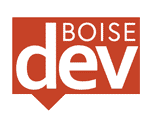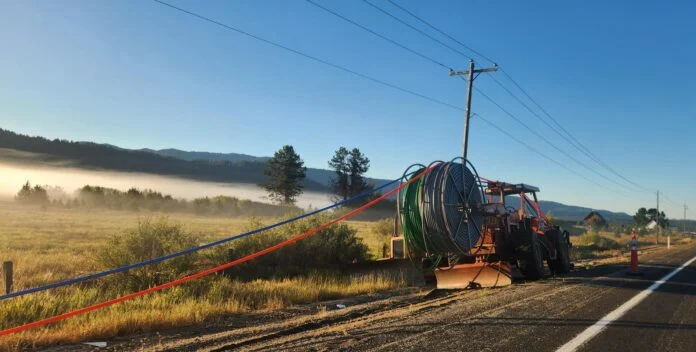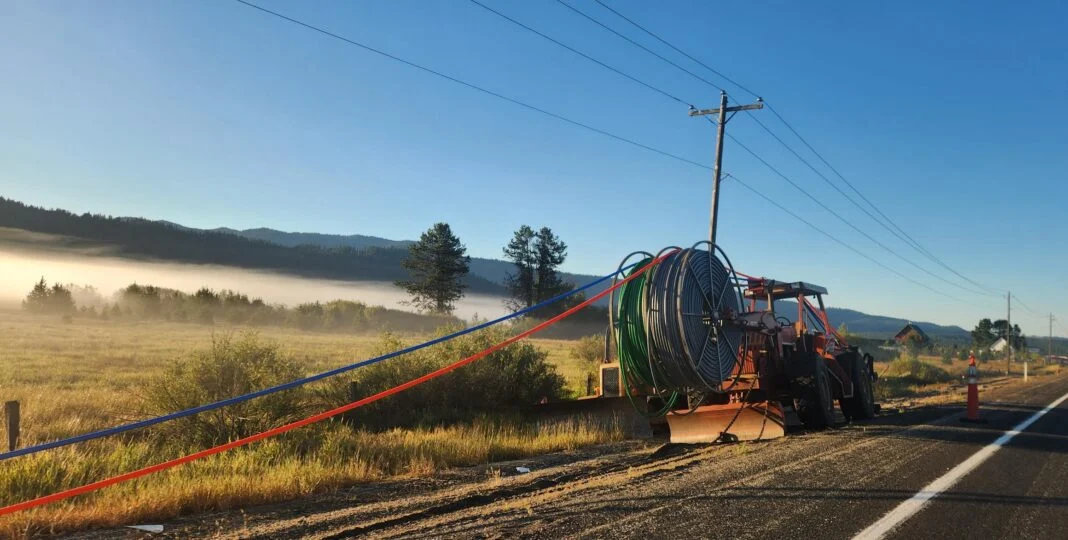Work that could resolve one of the biggest barriers to high-speed internet access in Valley County began this summer, but it is unclear how or when it may benefit local businesses and residents.
The Idaho Regional Optical Network (IRON) has been installing conduit for fiber internet lines this year in Valley and Adams counties along Idaho 55 and U.S. 95 as part of a 198-mile connection linking Star and Grangeville.
The connection includes 288 fiber strands directly linking much of west central Idaho to data centers that fuel high-speed internet access. IRON plans to make the strands available for lease by local businesses, internet service providers, and other entities.
The entirety of the route will be completed in 2027, although service in Valley County could be available sooner if needed, according to Brandon Coates, an IRON spokesperson.
Coates expects the route to “bring significantly increased opportunities” for high-speed internet access in places along the route, including McCall, Donnelly, Cascade, Smiths Ferry, New Meadows, and Riggins.
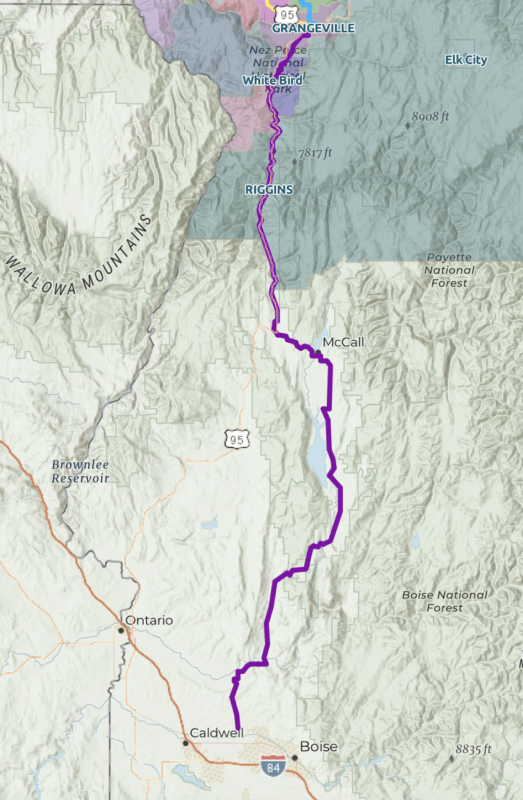
The $80 million “middle mile fiber” project is funded in part by a $20 million federal grant, with the remaining $60 million funded by IRON and the Intermountain Infrastructure Group.
Currently, internet speeds available in most of Valley County do not meet federal standards for remote work, education, or business. Bottlenecks caused by outdated copper internet lines have been known to disrupt credit card transactions at businesses during peak tourism periods.
While IRON’s middle mile route could resolve any speed deficiencies or data bottlenecks coming into Valley County, benefits could still be capped by “last mile” copper lines that transmit data many times slower than fiber.
Stalled public fiber network
A public fiber network owned by local governments was expected to be among the first entities to lease IRON’s middle mile lines, but an effort to build the network has stalled.
The West Central Mountain Fiber Network was formed in 2021 by local governments from New Meadows to Cascade to develop a high-speed internet network capable of serving more than 16,000 homes and businesses across Valley County and in the New Meadows area.
Building the network, which would consist mostly of last mile fiber lines beneath city and county roadways, was estimated to cost about $80 million by a 2022 study.
WCM Fiber also sought proposals for a middle mile fiber connection, like the one IRON is building, in 2022. Incumbent service provider Ziply Fiber said it would complete the work if local governments contributed $19.1 million, but that proposal was rejected.
WCM Fiber hoped to fund much of the work to build the network with federal grants, but still needed to raise millions for matching funds. Private financing proposals were sought, but did not come to fruition.
Besides a lack of funding, the collaborative is now facing a lack of expertise as McCall Information Systems Director Chris Curtin is set to retire in October.
“With Chris retiring, it’s going to be difficult to have the expertise needed to continue on an open network project,” Valley County Commissioner Sherry Maupin said. “Until future funding pathways are identified, (WCM Fiber) will remain dormant.”
Valley County committed $50,000 in federal grant funding to WCM Fiber, most of which was spent on consulting services. No consulting hours have been billed to the county since May 2023, Valley County Clerk Doug Miller said.
Without donors like you, this story would not exist.
Make a donation of any size here
McCall: still ‘committed’ to RAPID plan
The idea for a regional fiber network grew from McCall’s proposal for RAPID, a city-owned fiber network on which internet service providers could serve city residents at lower rates.
McCall Community Relations and Public Engagement Director Erin Greaves told Valley Lookout that the city “remains committed” to RAPID despite Curtin’s retirement.
“Our commitment to an open-access fiber network is about building for the future, not just meeting today’s needs,” Greaves said. “With thoughtful planning and the support of grants, we continue to expand the system so that, as opportunities arise, McCall will be ready to make fast and reliable broadband more accessible to residents and the wider region.”
The city is currently interviewing replacements for Curtin and hopes to make a hire in October, Human Resources Manager Traci Malvich said.
Curtin began developing plans for RAPID in 2019 and has since overseen the installation of more than 12 miles of city-owned fiber lines beneath city streets. Overall, he estimates up to $1.5 million has been spent on the project, including grant funding.
Currently, the city’s fiber links City Hall, the McCall Police Department, the McCall Municipal Airport, and other city departments on one secure, high-speed network. No homes or businesses are connected to the network.
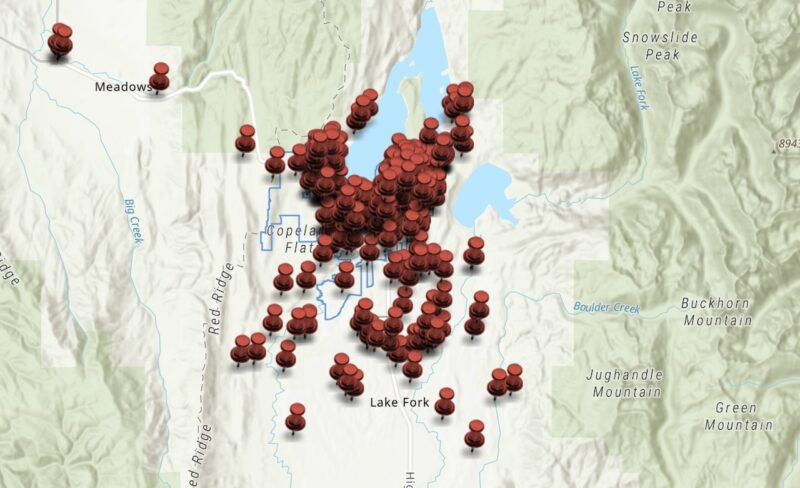
Test neighborhood in limbo
The city planned to launch RAPID with a test neighborhood in 2020, but it was delayed by the COVID-19 pandemic. In 2021, it moved to a regional focus and began working with WCM Fiber in hopes of increasing federal grant funding available for the work, Curtin said.
Now, there is no timeline for the service to be available to McCall residents and businesses. The city’s 2026 budget lists the test neighborhood as a “deferred project,” which Finance Director Randy Kyrias said indicates projects for which funding still needs to be identified.
Some $3.4 million would be needed to start deploying RAPID to neighborhoods from 2027 to 2029, according to the budget.
However, it is anticipated that much of the cost would be paid through Local Improvement Districts (LID), which would enable homeowners to pay back upfront costs over time on monthly bills.
Overall, it is estimated to take about 10 years for RAPID to be available throughout all of McCall once deployment begins. The service would be available on an opt-in basis and is estimated to cost about $50 per month, including LID repayment fees.
Ammon model
The city’s model for RAPID is based on a similar network developed in the City of Ammon, which is a suburb of Idaho Falls. Ammon successfully used LIDs to build a city-owned fiber network that now delivers high-speed internet to more than 16,000 addresses for about $50 per month.
The model lowers customer prices by allowing internet service providers to offer service through the network, thus lowering the barrier to entry in new markets and driving up competition among providers.
End-to-end high-speed internet first became available in select areas of Valley County this summer through a project being completed by Ziply Fiber, as Valley Lookout reported.



